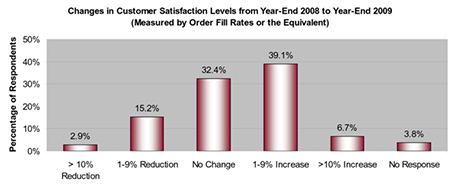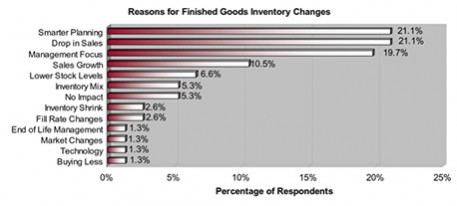Finished goods inventory levels fall, order fill rates rise
A new survey by Tompkins Supply Chain Consortium shows smarter planning tops the list of reasons for inventory changes.
Latest Logistics News
U.S. rail carload and intermodal volumes, for week of April 20, are mixed, reports AAR Baltimore suing ship that crashed into bridge, closing port, costing jobs Intermodal growth volume remains intact in March, reports IANA Descartes announces acquisition of Dublin, Ireland-based Aerospace Software Developments Amid ongoing unexpected events, supply chains continue to readjust and adapt More NewsInventory issues impact operations substantially, especially when it comes to finances. And, saving money by managing inventory efficiently is a major focus for most industry and market segments. Those are just two points brought to light in the Tompkins Supply Chain Consortium’s recent “Finished Goods Inventory Management” survey. The survey was conducted with participants from companies in the manufacturing, retail, and distributor sectors.
Findings also include how companies are organizing to manage their finished goods inventories, how they benchmark, their best practices, and how finished goods inventory and customer service were impacted in 2009. More than half of the companies surveyed by the Tompkins Supply Chain Consortium saw a decrease in inventory levels in 2009. But, according to the report, despite reduced inventory levels, customer satisfaction remained the same or improved for nearly 80% of these companies.
“In 2009, companies worked very hard reducing inventory levels to improve cash flow and positively impact company financials,” said Bruce Tompkins, the Consortium’s executive director and author of the report. “The expectation was that order fill rates would be negatively impacted as shortages and stockouts became prevalent. However, the reality is just the opposite: Order fill rates actually improved.”

The report, which is based on a survey of leading manufacturing and retail companies, reveals that while the economy sagged and sales were off, companies found ways to substantially reduce their finished goods inventory levels.
The top five reasons for these inventory changes given by survey participants are:
1. Smarter planning - 21%
2. Drop in sales - 21%
3. Management focus - 20%
4. Sales growth - 11%
5. Inventory mix - 5%
Other key findings from the report include:
In general, inventory management is performed at the corporate level. However, if the organization is very large, the division-wide management is most often found.
An inventory management department is often responsible for setting finished goods inventory targets, but the responsibility is typically shared by several supply chain functions.

Inventory turns, inventory balances and days of supply are the top three measurements used for finished goods inventory.
The supply chain areas in which changes are most needed with respect to this type of inventory are processes, people, and inventory policies.
Click here to download additional results from the Finished Goods Inventory Management Report.

Article Topics
Latest in Logistics
U.S. rail carload and intermodal volumes, for week of April 20, are mixed, reports AAR Baltimore suing ship that crashed into bridge, closing port, costing jobs Intermodal growth volume remains intact in March, reports IANA Descartes announces acquisition of Dublin, Ireland-based Aerospace Software Developments Amid ongoing unexpected events, supply chains continue to readjust and adapt Shipment and expenditure decreases trend down, notes Cass Freight Index March trucking tonnage trends down, reports ATA More LogisticsSubscribe to Logistics Management Magazine

Find out what the world's most innovative companies are doing to improve productivity in their plants and distribution centers.
Start your FREE subscription today.
April 2023 Logistics Management

Latest Resources














